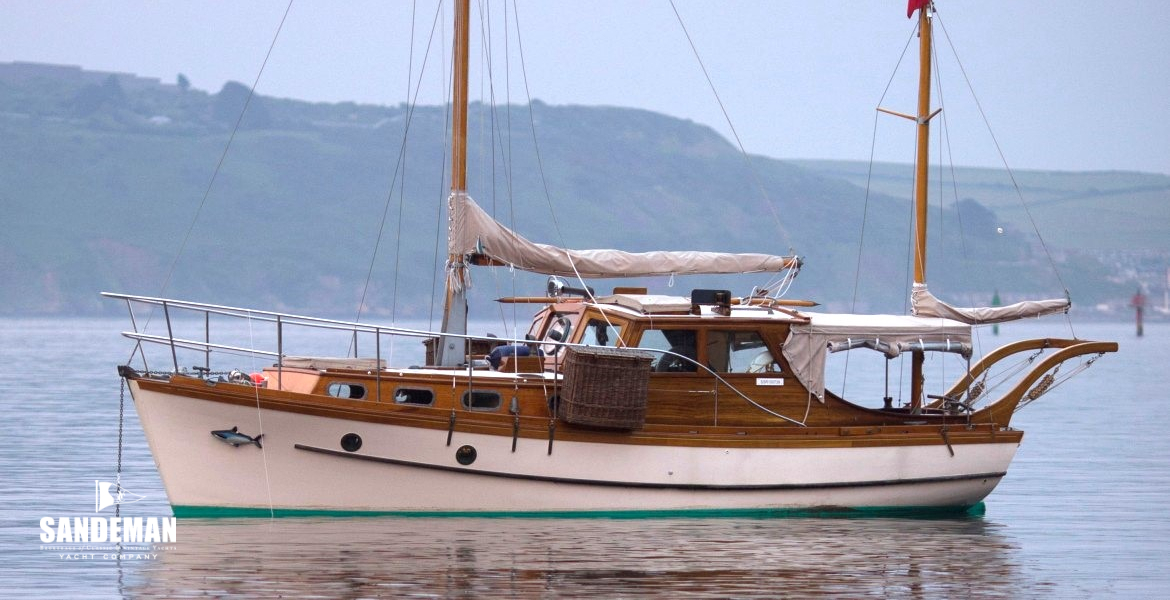
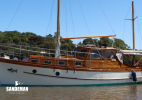

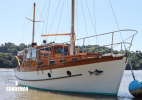
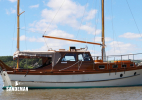
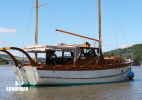
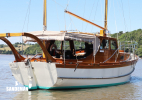
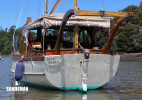
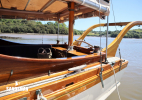
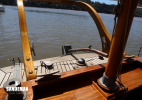
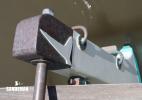
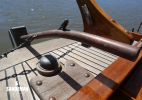

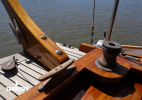

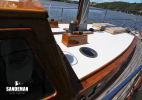
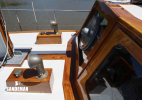
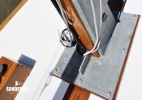
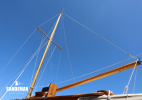
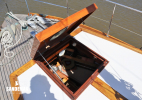
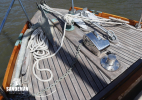
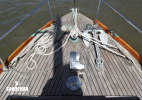
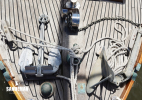
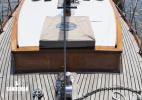

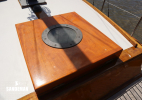
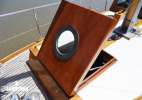
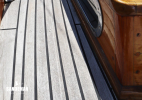
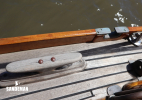
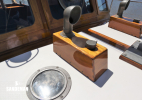
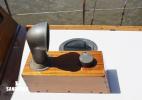
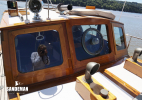
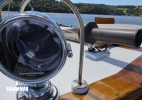
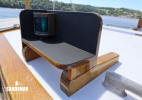
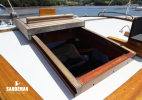

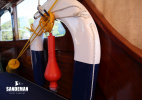
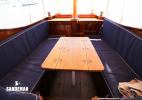
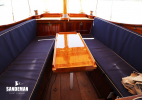
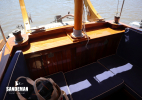
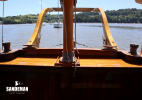
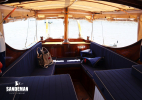
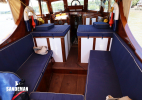
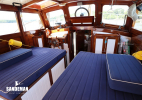
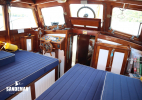
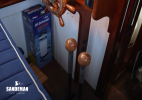


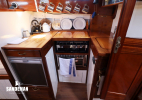
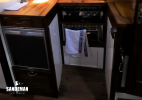
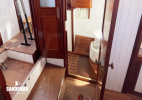
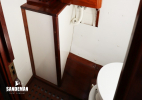
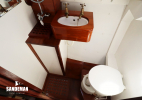
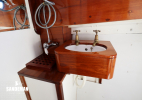

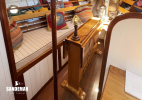
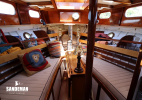
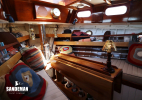
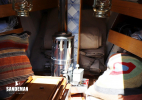
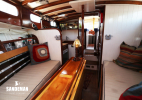
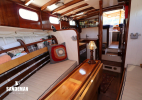
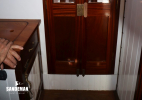
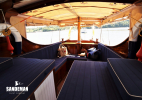
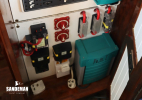
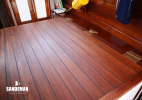

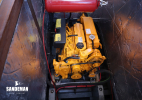
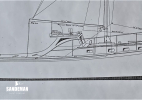
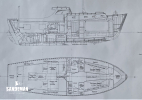
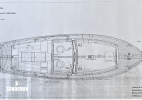
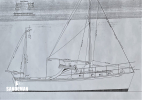
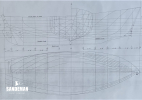
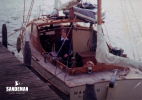

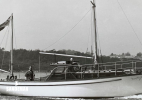
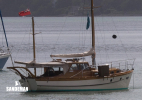

| Designer | Fred Parker |
|---|---|
| Builder | J.I. Thornycroft & Co Ltd., Hampton-on-Thames |
| Date | 1961 |
| Length overall | 34 ft 0 in / 10.36 m |
| Length deck | 30 ft 0 in / 9.14 m |
| Length waterline | 26 ft 8 in / 8.13 m |
|---|---|
| Beam | 9 ft 6 in / 2.89 m |
| Draft | 3 ft 6 in / 1.07 m |
| Displacement | 8 Tonnes |
| Construction | Teak planking on teak and oak |
| Engine | 2 x Vetus/ Mitsubishi 33 hp 4-cyl diesels (2012) |
|---|---|
| Location | United Kingdom |
| Price | GBP 95,000 |
These details are provisional and may be amended
‘Fishing Cruisers’ or ‘Motor Fishing Yachts’ were all the rage in post second world war England. Among new designs for all manner of yachts up to 100 ft / 30 m reviewed in the 1959 edition of Yachting World Annual, were no fewer than three fascinating and attractive 30-35 ft examples, but none to such a high quality build specification as A. Franklyn Pool’s Fred Parker-designed BLUE SHARK, planked with teak on a longitudinal frame of teak, and replete with a fish well in her large and deep cockpit. This second boat to the design originally began life in 1961 as HANDA II in the ownership of Lady Mary Grosvenor, younger daughter of the 2nd Duke of Westminster. Forty years later she was in need of restoration, but her almost all-teak hull offered a superb base to work from, while that deep, safe cockpit, and cosy accommodations, were just what her present owner was looking for in a pocket classic motor-sailer for coast and canals. A decade later she was ready, with improved space, comfort, and all the modern conveniences nowadays taken for granted but not often available in a classic motor-sailer of this size. BLUE SHARK is an enchanting delight.
Interested in BLUE SHARK [ex HANDA II] in more detail.
Enquire About BLUE SHARK [ex HANDA II] Download PDF Specification
In buying and restoring BLUE SHARK, the objectives were:
- To keep to the original plans
- To only make alterations that were both practical and sympathetic
- To use good quality materials in the restoration and fitting out
- To equip her to be as independent as possible of marinas
- To cruise European waters, inland and coastal, in comfort
The original plans are kept by the National Maritime Museum and a set was used in the restoration. Where changes were made, for example in the height and length of the wheelhouse roof, the drawings were altered.
Restoration commenced at the International Boatbuilding Training College (IBTC), Lowestoft, Suffolk, in 2003-4 and was completed in 2011. BLUE SHARK was relaunched in 2011, 50 years after her original launching as HANDA II. In 2012 her original Thornycroft engines were replaced.
Restoration included:
- hull stripped back to bare wood
- replacement of a few planks and frames in the hull
- seams raked out, re-puttied and caulked
- keel bolts drawn, inspected and replaced
- ransom was replaced.
- new teak on ply deck
- strengthening of the original cabin roof
- new wheelhouse
- new cockpit
- the addition of davits
- new cabin soles and furniture
- wheelhouse and cockpit all replaced.
- original, galvanised guardrail copied in polished stainless steel
- all fittings replaced including galvanised tabernacle; bow roller; rudder fittings; tiller
- original main mast repaired
- new main boom, mizzen mast and mizzen boom
- standing and running rigging all replaced with new
- almost all fastenings are of copper or bronze and internally, brass
- only copper or bronze can be found in the hull to reduce the effect of galvanic action
- original P brackets retained
- bronze shafts and stern tubes replaced
- new engines (2012)
- new propellers (2012)
- all electrics, plumbing and fittings new (details below)
- all superstructure re-varnished
- cabin and wheelhouse roofs re-finished 2020
- hull topsides re-painted 2020
FREDERICK R. PARKER LTD DESIGN NO: 1131
The original concept for this attractive little ship was a 'fishing cruiser' design for the West Country (south west of England), commissioned by Cornish copper products manufacturer Aubrey Franklyn Pool whose leisure pursuits were listed as fishing, motor yachting, and golf - in that order. This was the original BLUE SHARK, built of teak by Woodnutt & Co., at St. Helens, Isle of Wight, to Lloyd's ✠100A1; well publicised at the time in the yachting press and featured in the 1959 edition of Yachting World Annual.
The design seems to have caught the eye of Lady Mary Grosvenor, younger daughter of the, by then late, 2nd Duke of Westminster - probably then one of the richest women in the World - for use at the Grosvenor's vast Sutherland shooting estate of Kylestrome in north west Scotland. Lady Mary's introduction to yachting would have been aboard her father's 1200 ton four-masted schooner FLYING CLOUD, and his 263 ft twin screw, 4 x 5000 hp steam turbine powered naval destroyer yacht CUTTY SARK (though perhaps not when her father's beau Coco Chanel was on board).
In a lovingly written 2000 Daily Telegraph obituary, Lady Mary was described as, "A lover of outdoor life [who] rode, shot, stalked, fished, and showed Welsh ponies... very much at home under sail or in a motor boat, and in younger days... a keen [and successful] motor racing and rally driver, never happier than when stripping down the engine of a Bugatti."
The very high specification BLUE SHARK design was the perfect boat for Kylestrome, replicated in 1961 as HANDA II (after the island offshore from the estate) by Thornycrofts' Hampton-on-Thames yard - again to the same Lloyd's ✠100A1 teak on teak and oak specification. She served both Lady Mary and the estate for thirteen years, from 1964 sometimes accessed by the 4th Duke of Westminster’s Grumman Gosling flying boat.
HANDA II moved to her second owner probably in the early 1970s. The owner listed in the 1975 and 1976 editions of Lloyd’s Register of Yachts was S. Power of Tree Tops, Banks Road, Sandbanks, Dorset, but it is known for sure that by this time she was owned by Christopher Cracknell who had purchased the boat from a Mr. Richardson. Cracknell took HANDA II to France and the Scilly Isles several times and was complimentary about her sea keeping qualities in a Force 6-7.
There is then a presently unknown twenty years period of ownership before HANDA II was purchased for old time’s sake as a restoration project c.2000 by Andrew Pool, the son of the original BLUE SHARK’s owner. It was Pool’s intention to restore her, but age and the cost of restoration persuaded him to sell to her present owner in 2002.
In 2004 she was transported to IBTC, Lowestoft, where restoration commenced. In January 2010 the owner enrolled as a student there and worked almost exclusively on her until re-launch at 50-years-old in late 2011 – re-named BLUE SHARK after the demise of the original in Antigua.
Following the replacement of the original 32-40 hp Thornycroft RJD.2 diesel engines, BLUE SHARK sailed south to London in 2012, where she was kept at Brentford Marina. From there, she returned to the east coast, being moored first at Wivenhoe and then at Pin Mill. In 2016 she was brought round the coast, from Lowestoft to the Dart estuary, her present home, from where she has cruised west to Cornwall.
©2025 Iain McAllister/ Sandeman Yacht Company Ltd.
- Originally built to Lloyd’s highest class, ✠100A1
- 7/8 / 22 mm Teak carvel planking 4 in / 10 cm maximum width
- Copper fastened to English oak bent timbers
- Keel and stem of teak
- Iroko transom (2011)
- English oak floors
- Keel includes 762 kg of lead
- English oak bronze bolted bilge keels (2011)
- Iroko bilge stringers and beam shelf (2011)
- Laid teak on plywood deck (2011)
- Teak toerails and sheerstrakes (2011)
- English oak rubbing strakes (2011)
- Cabin roof is original on oak beams
- Teak cabin sides
- Original Simpson-Lawrence windows with new glass
- Original wrought iron hanging knees re-galvanised
- Additional strength is from iroko knees (2011)
- Solid iroko wheelhouse and cockpit sides (2011)
- Epoxy coated plywood wheelhouse roof (2011)
- Iroko beams (2011)
GENERAL
- Single level aft, side and fore decks
- Laid teak deck on plywood
- Deep cockpit, open aft wheelhouse, trunk cabin
- 'Cantrails' protect base of superstructures
- Varnished teak toerails
- Stainless steel pulpit and rail running aft to wheelhouse
FROM AFT
- Varnished laminated oak davits (cover with solar panel)
- Davit tackles
- Launcher for 10 kg Bruce anchor; bronze transom protection
- Tufnol blocks for steering lines
- Bronze rudder top, pintle and gudgeon (Classic Marine 2011)
- Bronze tiller with parrot decoration (Classic Marine 2011)
- Steps on rudder
- Bronze mushroom vent
- Raw greenheart mizzen cleats
- 2 x Tufnol/ bronze sheet winches
COCKPIT
- 2 x Gas bottle sealed and vented gas locker aft
- Seating port, starboard and aft
- Large enough to use as berths
- 3 x Large hinged lockers under
- Raw greenheart cleats port and starboard
- Bronze fairleads in toerail
- Solid raw iroko sole
- Bathing ladder stowed
- Iroko faced marine ply engine boxes; upholstered acrylic cushions
- c.50 mm Halyard sound insulation
- Engine boxes can convert to a double berth
- using 2 x chart boards and 2 x infill cushions
- Access to cabin then is under ths berth
- Original engine boxes spacious enough to stow folding bikes/ toolbox etc
WHEELHOUSE
- Helm position to port in solid iroko
- Ship's wheel
- 2 x Engine instrumentation panels
- Henry Brown & Son steering compass
- 2 x Portable chart boards
- Battery monitor displays (see below)
- Kent 'Clearview' screen and demister in fixed central windscreen
- 2 x Opening port and starboard windscreens
- All wheelhouse windows fitted with toughened glass
- Davey & Co brass stays and bronze hold down bolts
- 2 x Morse controls
- 2 x Large original gear levers
- Electrical locker to starboard in solid iroko
- 4 x Brass deckhead lights
- 1 x brass angled spotlight
- 1 x Compass light
- 12 V Sockets
WHEELHOUSE ROOF
- Bronze mainsheet horse
- Raw teak handrails
- Bronze cased running lights
- Solid iroko sliding hatch over helm position
- Brass horn controlled from wheelhouse
- Francis chromed searchlight controlled from wheelhouse
SIDEDECKS
- Greenheart mooring cleats port and starboard
- Associated inset bronze mooring fairleads
- Sheet leads
- Diesel and fresh water filler caps port and starboard
- Outlet for deck wash pump.
TRUNK CABIN
- Varnished iroko grab/ toe rails port and starboard
- 2 x Varnished teak dorade boxes with bronze vent cowls
- Circular roof ports port and starboard
- Galvanised main mast tabernacle (2011)
- Bronze mushroom vent
- Teak forehatch with circular port
FOREDECK
- 2 x Greenheart mooring cleats
- Bronze cleat
- Bronze mooring fairleads port and starboard
- Bronze mushroom vent
- 2 x Bronze bow rollers
GROUND TACKLE
- Lewmar electric windlass PR Series 1000
- Operated from helm or switch at windlass
- 35 lb / 16 kg CQR bower anchor on teak chocks
- 40 m Galvanised calibrated anchor chain
- Halls pattern stockless anchor on teak chocks
- Fisherman anchor
- 10 kg / 22 lb Bruce anchor with c.40 m of marked rode
DOWN TWO STEPS TO ACCOMMODATION
- Pair of mahogany doors with bevelled glass top panels
- Mahogany washboards for safety at sea
- Bulkheads and settee structures of marine ply trimmed/ faced with iroko
- Wide planked, solid iroko sole boards throughout, bronze screw fastened
GALLEY TO STARBOARD
- Cherry edged solid Scottish elm tops
- 2 x Burner gimballed stove and grill
- Oven under
- Fridge/ freezer
- Stainless steel sink
- Cherry edged elm cover
- Mixer tap and retracting salt water manual tap
- Drawer and lockers
- Plate racks and cup hooks
- Food locker
- Gas sensor
- Original Simpson Lawrence reglazed opening port in trunk side
- Deckhead port light
- Brass deckhead lamp
- Brass angled LED spotlight
WC COMPARTMENT TO PORT
- Mahogany entrance door
- 'Air head' composting toilet
- Avoids both pumping out and need for holding tank
- Ceramic sink inset in wood
- Slides in and out for ergonomics/ more space
- Brass hot and cold taps
- Thermostatic hot and cold shower
- Shower can also be used on deck
- Teak grate in sole
- GRP sump tray
- Original Simpson Lawrence reglazed opening port in trunk side
- Deckhead port light
- Brass deckhead lamp
- Brass angled LED spotlight
SALOON
- Solid Scottish elm drop leaf table on centreline
- Removable fiddles
- Drinks stowage under
- Also acts as step to hatch
- Settee berths port and starboard
- American cherry back planks
- Stowage under
- American oak Shelving to port and starboard
- Removable cherry fiddles and nets
- Refleks diesel cabin heater and flue forward
- Ceramic tiled aft face to chain pipe cover
- Stowage space forward
- Hatch in trunk deckhead forward
- Ship's clock and barometer
- 4 x Brass angled LED spotlights
- 4 x Brass deckhead lamps
- 2 x Lamps; 12 V sockets
- 6 x - Original Simpson Lawrence reglazed port lights in trunk sides
- 2 x Opening portlights in hull sides
- Mobile phone charging sockets
- 240 V Sockets
RIG
- Original spruce tabernacle-stepped main mast
- Single set of spreaders
- Main mast can be raised/lowered by 2 persons
- Douglas fir roller reefing main boom (2011)
- Douglas fir mizzen mast; forward angled single spreaders (2011)
- Douglas fir mizzen boom (2011)
- Mizzen can easily be lifted from its step
- Stainless steel standing rigging
- Running backstays for main mast
- Silicon bronze alloy bottle screws
SAILS
Traditionally cut in Dacron by by North Sea Sails
- Main sail with reefing points and batten pockets
- Mizzen
- Large staysail
- Small staysail
CANVASWORK
- 2 x Acrylic cockpit awnings
- One allows the cockpit to become an internal space
- Removable sides/windows all round; supported by stainless steel framework
- A smaller cockpit cover for when the boat not in use
- Covers for main and mizzen sails and for both hatches
- Summer acrylic covers to protect the topsides/varnish from the sun
- at the same time allow the wind to blow through
- Winter white 640 gsm PVC cover in three pieces
- Designed to cover the entire vessel (ends excepted) afloat or ashore
- Acrylic cockpit, wheelhouse, and cabin cushions
- Zipped with piped edges and, where needed, ties
- Cockpit cushions are double layered to keep the foam dry
GENERAL
- All skin fittings are bronze
- Stop cocks/ valves are all Blakes
MECHANICAL
All new propulsion system 2012
- 2 x Vetus/ Mitsubishi 33 hp 4-cylinder diesels
- Designed to run independently of each other
- 2 x Gearboxes
- 2 x Stainless steel drip trays
- 2 x Water separators
- 2 x Cooling water strainers
- 2 x Air vents
- 2 x Aluminium bronze shafts
- Stern tubes and logs new at installation
- 2 x Bronze 15 x 10 right hand bronze propellers
- Forward and reverse gears mechanically controlled by original levers
- Mechanical throttles mounted separately
- The wet exhausts run via Halyard GRP silencers; exit underwater
HYDRALIC
- Vetus wheehouse steering pump and ram
- Linked to stainless steel cables attached to tiller
- Tiller can be decoupled by a switch for tiller steering
ELECTRICAL
Batteries under wheelhouse floor forward of the engines
- Linked to allow the service batteries to be used for engine start
- 2 x 75 Ah starter batteries
- 4 x 108 Ah service batteries
- Mastervolt Masterlink BTM III battery monitor system
- Panel mounted by the helm position
Generator
- Honda EU20i, 4 stroke portable petrol generator
- For charging the batteries when stationary
- Located on the port side transom locker
- Bronze exhaust outlet
Solar panel attached to a small cover over the davits
- Used to keep the batteries charged when the boat is moored
Electrical locker starboard of helm
- 2 x Blue Sea DC power distribution panels
- Blue Sea safety hub fuse blocks
- Mastervolt AC Chargemaster
- Mastervolt AC Master inverter
- Both single circuit and dual circuit on/off battery switches
- Blue Sea systems bilge pump control panel
- Lewmar windlass fuse panel
Under the side deck, aft of the port engine
- Semloh mains consumer unit
- 2 x cables: one for connecting to shore power; other for the on-board generator
Cabling
All out of sight electrical cables are tinned and of correct size for load/ distance
All visible cables, principally for the lights, are from Pyrotenax copper tube
TANKAGE & ASSOCIATED SYSTEMS
Fuel
- Each engine has its own, original, re-conditioned, 35 Gal/ 159 L fuel tank
- Fuel tanks are linked to each other.
- Each fuel tank has its own on/off switch, fillers, and breathers
Water
- 4 x 316 Stainless steel tanks
- 1 x Original galvanised steel with cement wash interior
- All tanks connected
- Can be filled from port or starboard side
- Overflow on each side
- Total water tank capacity c.88 Gal/ 400 L
- Starboard engine cooling system routed via 36 L calorifier for hot water
- Flojet fresh water pump for pressure water system
- Johnson multiple port shower pump
Other
- Aquajet seawater deckwash pump
NAVIGATION
- Sestrel-Moore compass mounted forward of the helm
- 2 x Chart boards with Perspex covers
- Large enough for single sheet Imray charts
- Mounting for portable GPS on the port side
- Power/data cable link to the radio
- Raymarine ST60 + speed display
- Echopilot Forward looking depth sounder
- Barometer and clock in cabin
COMMUNICATIONS
- ICOM VHF marine transceiver
- Llinked to a Glomex marine antenna atop main mast
- Johnson submersible bilge pump with float switch
- Manual bilger pump in
- 2 x Perrybuoy horse shoe life buoys
- Tied to two danbuoys with battery powered lights
- 2 kg Dry powder fire extinguisher mounted inside each engine box
- 1 kg fire extinguisher in the wheelhouse
- 1 kg fire extinguisher near galley
- Bulkhead mounted fire blanket
- Gas detector in the galley
- Electrogas solenoid gas valve
- The 2 x gas bottles are linked to a single propane wallblock
- Gas proof gas locker locker in the transom
- Fuel cut-off valves outside the engine boxes
- Classic Marine bronze boarding steps and handles fitted to the rudder
- 2 x Means of escape from the cabin: forward hatch and through to the wheelhouse
- Stainless steel rail with pulpit runs from the stem to the aft end of the wheelhouse
- Aqua Signal Series 40 LED port, starboard, steaming (x 2), masthead and stern lights
- Pela oil extraction pump
- Extended handle for manual operation of windlass
- 2 x Small oak stools
- BBQ
- 2 x Dietz 76 brass storm lanterns
- 2 x Cherry, lead weighted LED lamps with brass shades
- Radar reflector
- Black foldaway motor sailing triangle
- Black foldaway anchor ball
- 2 x Removable painted carved wood Porbeagle sharks
- 2 x Bronze winch handles with yew grips; match engine throttle and gear levers
- Douglas fir boom/ lowered mast crutch
- Mooring lines
- Sheets
- 8 x Fenders
- 2 x Wicker fender stowage baskets (fit to guard rails)
- Davit falls
- Iroko beaching leg stays with galvanised steel feet
- 6 ft / 1.8 m mahogany ladder
- Floating tow rope
- Assorted ropes
- All blocks are made by HYE
- Code flags made of bunting
- 2 x Red ensigns, made of bunting
- 1 x Flagstaff
- 3 x Spruce handled boathooks: 1 heavy; 1 light; 1 ‘Grabit’
- Davey bronze hook heads. and weighted so handles float vertically
- 34 x 25kg lead ingots used for stiffening
- c.9 ft Davit-stowed GRP dinghy with rope rubbing strake, oars & rowlocks
- 8 ft GRP dinghy weighing 80 lb / 36 kg (small enough for a tender rack)
- Honda 4-stroke 2 hp outboard motor
- The original propellers (carried as spares)
- 2 x Brompton, fold-up bicycles with baskets, locks (stowed in the engine boxes)
- Blueprints, drawings
- Detailed notes of the restoration work
- Invoices
- Fitting manuals
- Instruction manuals
- Charts
- Cruising almanacs
Contact us to discuss BLUE SHARK [ex HANDA II] in more detail.
These particulars have been prepared from information provided by the vendors and are intended as a general guide. The purchaser should confirm details of concern to them by survey or engineers inspection. The purchaser should also ensure that the purchase contract properly reflects their concerns and specifies details on which they wish to rely.